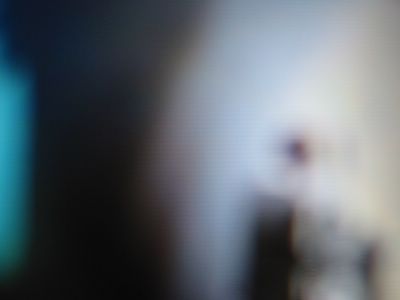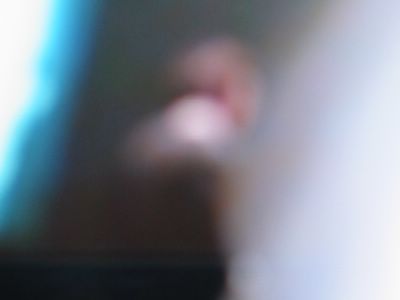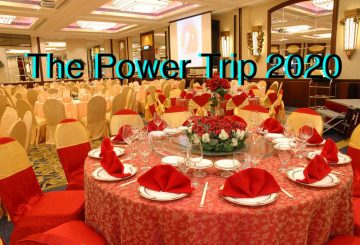It was amazing just how many people were at Scott Donovan’s Don’t Look Now night of video, sound and performance works. Held downstairs from Donovan’s space at Mori Gallery on Friday, July 29 and scheduled to kick off at 8.00pm, at 7.45pm mobs of people were already out on the street, beers and cigarettes in hand, or milling around in the large space as others created a human wedge at the bar. Mixing video screenings with live performances and complimented by two rooms of wall works and static video installations, it was a festival atmosphere with kids, dogs and Captain Video all present. Man, it was a happening! It had been years since we’d been to a night like it and although we had wondered how many people would turn up – and felt a terrible sense of dread when we spotted an electric guitar set up near the screening wall – we were pleasantly surprised to see such a huge crowd.

The duration of Don’t Look Now was estimated at two and a half hours with a finish set for 10.30pm, a huge ask for an event without proper seating. The cold hard floor of Mori is unforgiving – standing or sitting – and perhaps the whole idea was to wander around. The bar and gallery area served as an impromptu discussion lounge and the outside lawn was a refuge for those who badly needed a nicotine break. As much as we could see that this was a good plan, the audience seemed a little confused. Whenever you start a projector people stop and look at it and so, as the program kicked off, people stood and sat and stared at the wall. In an event like this, the audience and its reactions make or break an evening and for the most part people we’re well behaved. Sure, there was a precocious kid in the crowd who vocalized his thoughts just a little too loudly and a little too often, but everyone seemed to be there for a good time and a long time. That was until the first longish video. Kylie Wilkinson’s Search and Destroy was only 8 and half minutes long but people started getting restless. By the time Kate Murphy’s Prayers of a Mother kicked off its 14 minute run, the crowd broke for the bar or went outside and the discipline of audience and screen was destroyed for the rest of the night. By the time the event finished well after 11.30pm all decorum was abandoned with beer bottles on the floor, people drifting off into the night and hangers on finishing the wine.
The video component of the program dominated the evening demonstrating once more – if it ever needed demonstrating again – that video has subsumed just about all other practices in time based art. Its reception is so easy and second nature to audiences now that although there were actual people doing actual live performances in the space, these too were dominated by a relationship to a screen. Why did the performnace artist cross the road? To press PLAY. But before we get to the live stuff, let’s talk about the video
It doesn’t really need to be pointed out that the way videos are watched in a gallery installation differs immensely to the way we watch a film in a cinema, TV at home or movies on the web. The mode of reception between a time based narrative and a static image in a photograph or a painting sets up a cognitive disjunction in a gallery setting. We tend to take in static works quickly and process the information slowly letting the sequences of a show play out, the connective meanings and conjunctions emerging later. With most video art we tend to become both more active interpreting montage relationships, yet at the same time more passive as we allow duration to affect these readings. For this second mode of reception we, as an audience, have been trained into wanting physical comfort [in the cinema, at home] with food, drink on hand. Take either of those away and the interpretation of long form, complex narratives can become extremely demanding. Artists who have twigged that a 30 minute narrative video never works as an installation have turned to short form simple pieces that allow the gallery goer to ‘get’ what is happening quickly and move on. Others who have attempted more complex narrative constructions usually allow at least for the arse-comfort factor and provide chairs or benches. If we’re going to sit here for 30 minutes, we want comfort.
The video works in Don’t Look Now tended to fall into one of two types: very short pieces less than 5 minutes or longer form works up to 15 minutes. In the former category were works such as Euan McDonald’s Three Trucks [2.10] that recorded the meeting of three ice cream vans on a street in LA, Steve Carr’s Car Crash [0.30] a video of kids silently smashing up a truck with sledge hammers and Justene William’s Tap & Toilet [1.12], featuring the artist tap dancing in her bathroom. These works went down a treat, getting in and doing there thing quickly, then getting out. Longer form works such as Wilkinson’s Search and Destroy which interviewed young people in Shanghai about their hopes and dreams didn’t fare so well. The previously mentioned Prayers of A Mother by Kate Murphy, apparently designed for a installation set up with multiple screens, was presented mono channel. It took a while for the audience to figure out that the faces floating left and right of a woman discussing her long list of prayers were her sons and daughters. For the people who stayed to the end of the piece, the length was rewarded by a sense of humour by video maker and subject that was persuasive.
Brendan Lee had two works in the program, Plain Old Video [2.43] and Mythologies of Film [1.47]. Lee’s videos that examine the narrative tropes in Hollywood cinema have an almost quaintly old fashioned feel to them in the way they are so conceptually tight. Plain Old Video was lifted complete from a film or films with plane crash footage and edited into a bizarrely long and uncomfortable airline conflagration with people being ripped from their seats and fireballs engulfing Economy Class. Mythologies of Film was a single shot of Lee with projections on his face recreating one trope of science fiction and tech films which show that video monitors project their information on to the user’s face. Compared to the long form and shorter works, Lee’s video sat in a middle ground that seemed to leave the audience a little perplexed. [“Oh my god!” said the little kid as the plane went down.] Another work all on its own was Peter Newman’s Rosebud [10.40]. The work consisted of what looked like melted film emulsion that had been colourised and animated creating a series of quickly flickering abstract images that resembled crystals in a cave. The images were accompanied by a rising noise that grew in volume and intensity as the piece continued. The association of one abstraction with another was immensely powerful.

It’s curious that in a medium such as video the sound in a lot of the works should adhere so closely to an all or nothing approach as if mimicking the on/off duality of digital encoding. Low tones, massively loud noises and static – or complete silence – are the unfortunate cliché’s of audio in time based art. Finding a work with a subtle and nuanced understanding of sound is rare but we found a couple. Black Dice’s Tree Tops [6.37] was an intense and psychedelic video work of shifting moiré patterns and the sound – edgy static, blasts of noise, silence – complimented the visual perfectly [or vice a versa]. The most subtle use of sound was a piece from Germany by David Strebel called Office. Using a long zoom lens, the artist shot workers in their offices doing mundane things such as talking with colleagues, getting dressed to leave, lighting cigarettes or typing on keyboards. Over a general background ambience the artist placed closely miked sound effects to match only one action in the scene [a cigarette being lit, papers being flipped]. The distance between the viewer and the subject became conflated so that intimate sounds served to underscore the creepy voyeurism of the work. [Speaking of voyeurism, we had a close encounter in the toilets at Mori during the second break. While waiting outside the cubicles we realised that more than one person occupied the stall to the right. There was whispered talking followed by suspicious silences and when the door opened two guys walked out with sheepish looks on their faces. One of them was wearing a funny hat and we thought, what is this – a rerun of the early 90s?]
Several of the live works, as we mentioned, used video. Conductor did a performance that involved a bloke drawing on a canvas that had been wired for sound. As he drew on the canvas – and created what looked remarkably like a sketch for an Eduardo Paolozzi sculpture – pick ups in the canvas and on the guy’s hands transmitted coarse synthetic sound blasts to speakers. A camera captured the action and transmitted a black and white image to a projector that put up an image on the big wall. The low grade video image and the wooooh-wooooooh sounds reminded us of old Dr. Who episodes where someone’s brain is overtaken by aliens and they have a psyche out. Conductor’s work was both a bombastic and absurdly overdone demonstration of a not very interesting concept and a persuasive and utterly convincing creation of old world Modernist experimentation. We couldn’t decide which.
In a similar vein of obviousness Who Falls Was – live performance by Dabek/Encarnarcao/Smyly was a live music accompaniment of a video of view out of a train window, starting in the city and ending up in the misty woods. It was the guitar piece we had been dreading [with terrible memories of Art Unit] and we’re pleased to say that the guy who played it knew what he was doing. It was a lovely sound performance – pity about the visuals – it’s something we’ve seen many times before. The only point of interest was the location of the video. It looked European. “Where was that video shot?” someone yelled out afterwards. “Paris,” came the timid reply a few moments later. We love Paris in the springtime.
Checking our watches and noting the lateness of the hour, not to mention the increasing decrepitude of the space, we wondered if we’d stick it out to the end. Nursing a beer and wondering why there isn’t more hang gliding in contemporary art, our curiosity was answered by the next performance called Ovine Yonie, a band featuring Kyle Ashpole, Simon Cavanaugh, Sam Hughes and David Thomas. A video flickered into life and there was the band upstairs in Scott Donovan’s gallery bashing away on their instruments like post punk no hopers starigh outta The Hopetoun circa 1983. The sound, the music and the image were dreadful but to our delight the group had chosen to mediate their already mediated ‘live’ performance by inserting footage of hang gliding shot at Stanwell Tops into the feed from the gallery. So that’s where all the hang gliding went! [We also noticed that the guy with the hat we had seen in the toilets was in the band as well and realised that they hadn’t been taking drugs but giving each other last minute tips on chord changes].
Ovine Yonie were awful and went on for 15 incredibly long minutes. We were ready to call it quits. Luckily, we stayed and caught Joyce Hinterding and David Haines performances. Hinterding had no visuals to her work, just sound, and used two electronic hula hoops to generate a low hum and high static. When she put the two hoops together the sounds mixed and it was like listening to the music of the spheres. It was beautiful and calming and just what we needed. Haines sound piece was an almost seamless continuation of Hinterding’s and we have no idea what he was doing as he squinted at a laptop computer, but the subtle tone was just as good. We decided to go out on a high.

